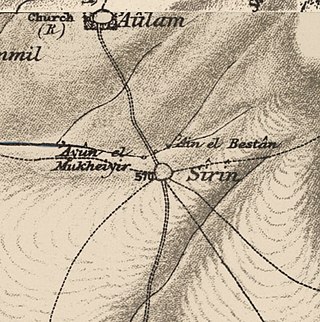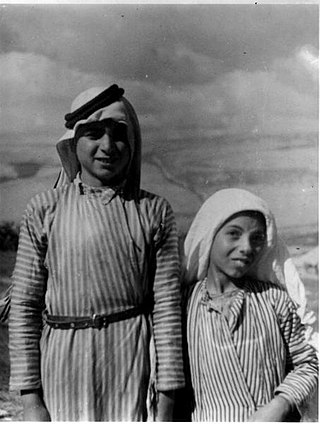
Al-Qastal was a Palestinian village located eight kilometers west of Jerusalem and named for a Crusader castle located on the hilltop. Used during the 1948 Arab–Israeli War as a military base by the Army of the Holy War, virtually all of its residents fled during the fighting and the village was eventually captured by the Palmach.

Umm al-Fahm is a city located 20 kilometres northwest of Jenin in the Haifa District of Israel. In 2022 its population was 58,665, nearly all of whom are Arab citizens of Israel. The city is situated on the Umm al-Fahm mountain ridge, the highest point of which is Mount Iskander, overlooking Wadi Ara. Umm al-Fahm is the social, cultural and economic center for residents of the Wadi Ara and Triangle regions.

Subbarin was a Palestinian Arab village located 28 kilometers south of Haifa. It was depopulated and destroyed during the 1948 Palestine war as part of the 1948 Palestinian expulsion and the Nakba.

Sandala is an Arab village in the Northern District of Israel. Near Afula, it falls under the jurisdiction of Gilboa Regional Council. In 2022 its population was 1,710.
Kafr Dan is a Palestinian village in the Jenin Governorate, located 8 km northwest of Jenin in the northern West Bank. According to the Palestinian Central Bureau of Statistics (PCBS) census, the town had a population of 5,148 in 2007 and 6,591 in 2017.
At-Tayba is a Palestinian village in the West Bank, located 18 km northwest of the city of Jenin in the northern West Bank, and 2 km east of Umm el-Fahm in Israel. According to the Palestinian Central Bureau of Statistics, the town had a population of 2,386 inhabitants in mid-year 2006 and 2,215 in 2017.

Silat al-Harithiya is a Palestinian village in the Jenin Governorate of Palestine, located 10 kilometres (6.2 mi) northwest of Jenin in the northern West Bank. According to the Palestinian Central Bureau of Statistics census, the town had a population of 9,422 in 2007 and 11,449 in 2017.
Jalamah or Jalameh is a Palestinian village in the West Bank, located 5 km north of the city of Jenin in the northern West Bank. According to the Palestinian Central Bureau of Statistics, the town had a population of 2,304 inhabitants in mid-year 2006 and 2,268 in 2017.

Meir Shfeya is a youth village and agricultural boarding school in northern Israel. Located near Zikhron Ya'akov, it falls under the jurisdiction of Hof HaCarmel Regional Council. In 2022 it had a population of 365.

'Anin is a Palestinian village in the West Bank governorate of Jenin. According to the Palestinian Central Bureau of Statistics, the village had a population of 4,216 inhabitants in 2017.

Lajjun was a large Palestinian Arab village located 16 kilometers (9.9 mi) northwest of Jenin and 1 kilometer (0.62 mi) south of the remains of the biblical city of Megiddo. The Israeli kibbutz of Megiddo, Israel was built 600 metres north-east of the depopulated village on the hill called Dhahrat ed Dar from 1949.

Sirin, was a Palestinian Arab village located 17 kilometers (11 mi) north of Beisan. The village was depopulated and destroyed in 1948. Only the village cemetery and one house remain standing, along with the remains of a mosaic pavement and a vaulted spring dating to the Byzantine period. Mentioned in historical documents, the 1596 census indicated it had 45 households; by 1945, the number of inhabitants had risen to 810.

Al-Kafrayn was a Palestinian village in the Haifa Subdistrict. It was depopulated during the 1947–48 Civil War in Mandatory Palestine on 12 April 1948 as part of the Battle of Mishmar HaEmek. It was located 29.5 km southeast of Haifa.

Al-Rihaniyya was a Palestinian Arab village in the Haifa Subdistrict. It was depopulated during the 1947–1948 Civil War in Mandatory Palestine on 30 April 1948 as part of the battle of Mishmar HaEmek. It was located 25 km southeast of Haifa and 3 km northwest of Wadi al-Mileh.

Ayn al-Mansi was a Palestinian Arab village in the District of Jenin of the Mandatory Palestine. It was depopulated as a result of a military attack in mid-April during the 1947–48 Civil War in Mandatory Palestine.

Nuris was a Palestinian Arab village in the District of Jenin. In 1945, Nuris had 570 inhabitants. It was depopulated during the 1948 War on 29 May 1948 under Operation Gideon. The Israeli moshav of Nurit was built on Nuris' village land in 1950.

Musmus is an Arab village in Haifa District. The village is located in the Wadi Ara area of the northern Triangle, 4 kilometres (2.5 mi) northeast of Umm al-Fahm. Since 1996, it has been under the jurisdiction of the Ma'ale Iron local council. The village is divided into five neighborhoods: Abu Shehab, Ighbarieh, Southeast, Mahagna, and Sharqawi. In mid-2016, Musmus' population was 4,215, all of whom were Muslim.
Most of the villagers belong to the Ighbarieh and Mahagna clans. The village is the birthplace of the poet Rashid Hussein. Highway 65 passes through the village and splits it into two parts.

Al-Musheirifa is an Arab village in Israel's Haifa District. The village is located in the Wadi Ara area of the northern Triangle, 4 kilometres (2.5 mi) northeast of Umm al-Fahm. Since 1996, it has been under the jurisdiction of the Ma'ale Iron local council. In mid-2016 Musheirifa's population was 3472, all of whom are Muslim. The village is divided into four neighborhoods: Ighbarieh, El-Manshya, Jabbarin, and the Old Village. The inhabitants are largely members of the Ighbarieh clan, which inhabits the upper parts of the village, and the Jabbarin clan, which inhabit the lower parts. Bayada was a neighborhood of the village in the past but split from it and became a new village. The village has poor infrastructure and, like many other villages in the Wadi Ara region, lacks many social institutions and recreational areas.
Zalafa is an Arab village in Israel's Haifa District. The village is in the Wadi Ara area of the northern Triangle, 4 kilometres (2.5 mi) northeast of Umm al-Fahm. Since 1996, it has been under the jurisdiction of the Ma'ale Iron local council whose headquarters is in the village. The village is divided into three neighborhoods: East, West and al-Murtafi'a. In mid-2016, Zalafa's population was 4,639, all of whom are Muslim.

Mu'awiya is an Arab village in Israel's Haifa District. The village is in the Wadi Ara area of the northern Triangle and lies between Kfar Kara and Umm el-Fahm. The village has around 3,100 residents. Since 1996, it has been under the jurisdiction of the Basma local council. The village is divided into two neighborhoods: eastern and western. The residents of the village belong to two clans: Ighbarieh and Mahmid.


















